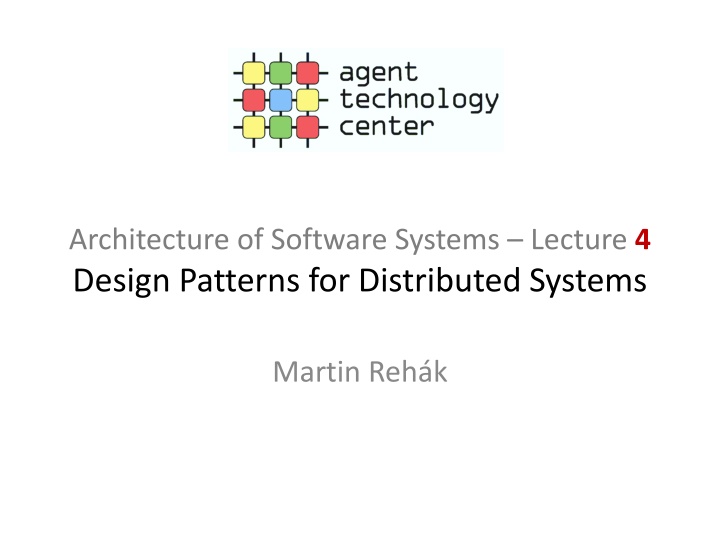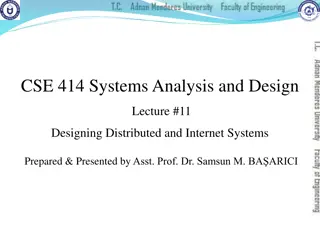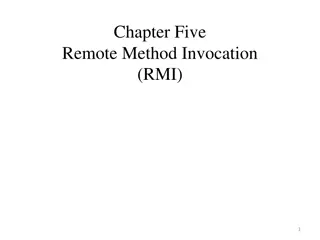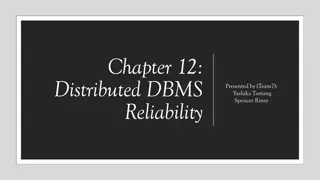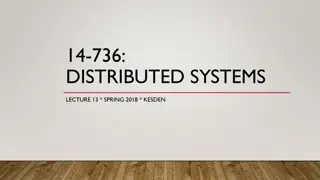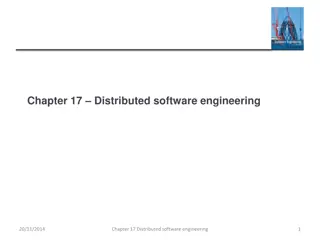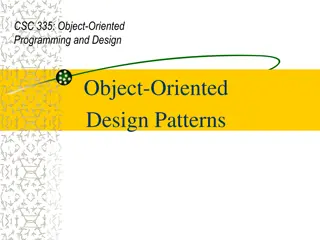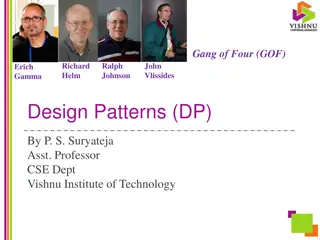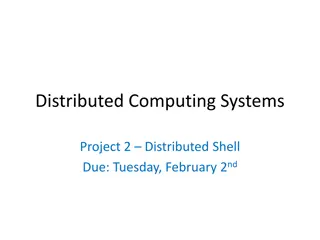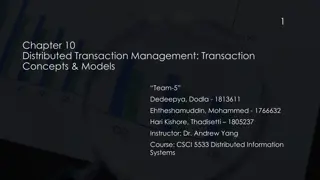Design Patterns for Distributed Systems Overview
This content delves into selected design and architectural patterns for distributed and multiplatform computing, emphasizing the paradigm shift, distribution issues, and the use of Facade patterns in software systems.
Download Presentation

Please find below an Image/Link to download the presentation.
The content on the website is provided AS IS for your information and personal use only. It may not be sold, licensed, or shared on other websites without obtaining consent from the author.If you encounter any issues during the download, it is possible that the publisher has removed the file from their server.
You are allowed to download the files provided on this website for personal or commercial use, subject to the condition that they are used lawfully. All files are the property of their respective owners.
The content on the website is provided AS IS for your information and personal use only. It may not be sold, licensed, or shared on other websites without obtaining consent from the author.
E N D
Presentation Transcript
Architecture of Software Systems Lecture 4 Design Patterns for Distributed Systems Martin Reh k
Overview Selected Design & Architectural patterns for Distributed/Multiplatform computing Content based on: Douglas C. Schmidt, Pattern Oriented Software Engineering Gang of Four: Gamma, Helm, Johnson, Vlissides; Design Patterns: Elements of Reusable Object- Oriented Software (Guerraoui/Rodrigues: Introduction to Reliable Distributed Programming)
Paradigm Shift From local to distributed Explicit vs. implicit Latency Failures Safety: a property is a safety property if it can never be restored once it is broken (e.g. the link will never insert a non-existing message into the media) Liveliness: can be restored anytime in the future (e.g. subsystem will answer the request)
Distribution Issues 1. Remote resource localization 2. Remote resource creation and usage 3. State synchronization management 4. Failure detection 5. Failure management, recovery and failover 6. Resource destruction
Facade Fa ade pattern hides the complexity and heterogeneity of system, subsystem or library behind a simple interface Typically replaces/hides more than one object Simplifies client access Allows transparent resource management Allows transparent lazy initialization
Facade vs. Interface Interface (in Java sense) is far more restricted than Fa ade Only defines a contract between the library/implementing class and its user programmer Fa ade pattern allows active handling of more complex issues than actual business logic Most of the code in distributed applications is NOT directly related to business logic
(Wrapper) Faade Example: JDBC Java Database Connectivity provides a unified API for most database work in Java Unified methods and constants Uses the Adapter pattern to incorporate third- party DBMS drivers Successfully hides most of the connection complexity/decisions from the Application Developer
Adapter/Wrapper The Adapter pattern provides mapping between two (isofunctional) interfaces Ensures syntactic and semantic compatibility of calls
Wrapper Faade The Wrapper Facade design pattern encapsulates the functions and data provided by existing non- object-oriented APIs within more concise, robust, portable, maintainable, and cohesive object-oriented class interfaces Douglas C. Schmidt, C++ Report 1999 Usages: Java Swing ACE/ORB Platform independent threading/synchronization libraries ACE Library
Proxy Proxy pattern is a local representation of a remote object, interface or library Rarely used alone, frequently combined with Fa ade, Wrappers and other Patterns AbstractService service Client Proxy Service 1 1 service service The Proxy Pattern (Douglas Schmidt, POSA)
Failure Propagation (1) An example of (easy) failure in a distributed system why distribution matters Two components: (A) Thermometer, with HTTP REST API, returns temperature as string (B) Client, using the thermometer to measure swimming pool temperature What could go wrong?
Failure Propagation (2) Thermometer breaks down and system generates random noise. In case of thermometer failure, some pools got to boil
Failure Propagation (3) Thermometer breaks down and system generates random noise. In case of thermometer failure, some pools got to boil Solution: Use -1 in the reply as a failure indicator, as text handling is unsupported in pool controllers
Failure Propagation (4) BUT: Thermometers are also used in Europe (on ski slopes), with Celsius scale instead of Fahrenheit -1 is completely plausible value and leads to shutdown of snow canons for ski resort customers
Stateful vs. Stateless design State consistency and resource management are the points where most abstractions break in real life: CORBA COM/DCOM/OLE Alternative approaches make the distribution EXPLICIT and incorporate it into the design from the beginning Messaging HTTP-based architectures/APIs
Active Object The Active Object design pattern decouples method execution from method invocation to enhance concurrency and simplify synchronized access to objects that reside in their own threads of control. D. Schmidt, et al. 2007 Agents/Multi-Agent Systems and OLTP systems are most frequently based on Active Objects (Messaging)
What is the downside of AO? Asynchronous operation handling is pushed to client Scalability and efficiency. Active Object is based on the assumption that the task performed by the object has a uniform resource consumption. This assumption is almost never true, especially in case of web servers or other IO-heavy systems. Hence the motivation for Reactor and Proactor. Reactor and Proactor provide transparent sync-async transition and efficient resource allocation.
Reactor The Reactor architectural pattern allows event-driven applications to demultiplex and dispatch service requests that are delivered to an application from one or more clients. (Schmidt) Reactor Event Handler * handle_events() register_handler() remove_handler() dispatches handle_event () get_handle() owns * Handle * notifies handle set <<uses>> Concrete Event Handler A Concrete Event Handler B Synchronous Event Demuxer handle_event () get_handle() handle_event () get_handle() select ()
Proactor The Proactor architectural pattern allows event-driven applications to efficiently demultiplex and dispatch service requests triggered by the completion of asynchronous operations, to achieve the performance benefits of concurrency without incurring certain of its liabilities. (Schmidt) Initiator <<uses>> <<uses>> <<invokes>> <<uses>> is associated with Asynchronous Operation Asynchronous Operation Processor Handle Completion Handler * execute_async_op() async_op() handle_event() <<demultiplexes & dispatches>> <<enqueues>> <<executes>> Asynchronous Event Demuxer Proactor Completion Concrete Completion Handler Event Queue handle_events() get_completion_event() <<dequeues>>
Reactor/Proactor Web server Concurrency The server must perform multiple client requests simultaneously; Efficiency The server must minimize latency, maximize throughput, and avoid utilizing the CPU(s) unnecessarily. Programming simplicity The design of the server should simplify the use of efficient concurrency strategies; Adaptability Integrating new or improved transport protocols (such as HTTP 1.1 [3]) should incur minimal maintenance costs. Schmidt, 1997 (NOT a Proactor/Reactor)
Reactor Connection 1. The Web Server registers an Acceptor with the Initiation Dispatcher to accept new connections; The Web Server invokes event loop of the Initiation Dispatcher; A client connects to the Web Server; The Acceptor is notified by the Initiation Dispatcher of the new connection request and the Acceptor accepts the new connection; The Acceptor creates an HTTP Handler to service the new client; HTTP Handler registers the connection with the Initiation Dispatcher for reading client request data (that is, when the connection becomes ready for reading ); The HTTP Handler services the request from the new client. 2. 3. 4. 5. 6. 7. 8.
Reactor Request Processing 1. 2. The client sends an HTTP GET request; The Initiation Dispatcher notifies the HTTP Handler when client request data arrives at the server; The request is read in a non-blocking manner such that the read operation returns EWOULDBLOCK if the operation would cause the calling thread to block (steps 2 and 3 repeat until the request has been completely read); The HTTP Handler parses the HTTP request; The requested file is synchronously read from the file system; The HTTP Handler registers the connection with the Initiation Dispatcher for sending file data (that is, when the connection becomes ready for writing ); The Initiation Dispatcher notifies the HTTP Handler when the TCP connection is ready for writing; The HTTP Handler sends the requested file to the client in a non-blocking manner such that the write operation returns EWOULDBLOCK if the operation would cause the calling thread to block (steps 7 and 8 will repeat until the data has been delivered completely). 3. 4. 5. 6. 7. 8.
Proactor - Connection 1. The Web Server instructs the Acceptor to initiate an asynchronous accept; The Acceptor initiates an asynchronous accept with the OS and passes itself as a Completion Handler and a reference to the Completion Dispatcher that will be used to notify the Acceptor upon completion of the asynchronous accept; The Web Server invokes the event loop of the Completion Dispatcher; The client connects to the Web Server; When the asynchronous accept operation completes, the Operating System notifies the Completion Dispatcher; The Completion Dispatcher notifies the Acceptor; The Acceptor creates an HTTP Handler; The HTTP Handler initiates an asynchronous operation to read the request data from the client and passes itself as a Completion Handler and a reference to the Completion Dispatcher that will be used to notify the HTTP Handler upon completion of the asynchronous read. 2. 3. 4. 5. 6. 7. 8.
Proactor - Processing 1. 2. The client sends an HTTP GET request; The read operation completes and the Operating System notifies the Completion Dispatcher; The Completion Dispatcher notifies the HTTP Handler (steps 2 and 3 will repeat until the entire request has been received); The HTTP Handler parses the request; The HTTP Handler synchronously reads the requested file; The HTTP Handler initiates an asynchronous operation to write the file data to the client connection and passes itself as a Completion Handler and a reference to the Completion Dispatcher that will be used to notify the HTTP Handler upon completion of the asynchronous write; When the write operation completes, the Operating System notifies the Completion Dispatcher; The Completion Dispatcher then notifies the Completion Handler (steps 6-8 continue until the file has been delivered completely). 3. 4. 5. 6. 7. 8.
Reactor vs. Proactor Processing connections in web server. Reactor (left) vs. Proactor (right)
From design to code and towards reactive programming PRACTICAL EXAMPLES
Runnable Simplest Async Execution new new Thread( new new Runnable(){ public public void try try { Thread.sleep(1000); System.out catch catch (InterruptedException e) { e.printStackTrace();} } } ).start(); Thread Runnable instance void run() { Method out.println("inside" "inside");} See details in David s presentation
Using Callable and Future We might need to return value Callable<Long> callable = new public public Long call() throws Long a = new Thread.sleep(1000 * a); return return a;} }; new Callable<Long>() { throws Exception { new Long(System.currentTimeMillis() % 5); Callable instance Method And run it using an ExecutorService ExecutorService executorService = Executors.newSingleThreadExecutor(); Future Future<Long> fRes = executorService.submit(callable); [exception handling]... Long aLong = fRes.get();
Executors Key ExecutorService methods: execute(Runnable) execute Runnable submit(Runnable) execute Runnable and return null Future on success submit(Callable) execute a callable invokeAny(collection of Callable) execute Callables and wait for any (the first) result invokeAll(collection of Callable) execute Callables and wait for all results Executors are provided in many flavors, can be extended (build your own): Single Threads, Thread pools,
Lambda functions - motivation Callback interfaces are traditional in Java: something.subscribe(new CallbackListener(){ public int sum(int a, int b){ return a+b; }; }); One trivial operation: one class, one method, 5 lines how many tests? Similar pattern for filters, search, comparators,
Lambda functions (for those who dont know it yet) Procedural (Imperative ) vs. Functional programming In Java, everything is an object Object-oriented approach is compatible with both Imperative and Functional styles Until recently, Imperative approaches were dominant Not (so much) today due to changing nature of IT Java was, until very recently, a procedural, object- oriented language Competition from Scala, .NET and other factors pushed it to adopt more functional paradigm
Lambda functions under the hood Couple of issues: To which class (class structure) does the function belong to Important for access control and other issues There are two ways how to approach the problem: Create anonymous inner class under the hood at compile time But (even anonymous/inner) classes are not free they consume memory invokedynamic build the representation at runtime (on first invocation) and call it one or more times Static method + factory instance Inner class (still theoretically possible ) anything that any compiler might deem efficient in the future
Reactive programming and Observables Observer: (very traditional) pattern where an object (subject) holds a list of listeners that get notified by the object about (any) state changes ReactiveX: Functional-like reactive programming approach that allows efficient decoupling between Event happening Transformations on the event data Reaction to an event Similar to Java 8 Streams, but on a different level Exists across many programming languages
Observer Subject keeps reference to 0-n Observers add(), remove() Observers get notified about any status change w.r.t. subject - update() David Geary, An inside view of Observer, Javaworld, 2003 very old!
Modern Incarnation Reactive Rx framework takes the Observer framework forward by combining it with multiple inspiration sources: Observer Null Pointer exceptions and hanging references Functional programming map, reduce, operator chaining lambda functions make syntax bearable Scala, Java streams Agent (Active object), Actor models, Erlang, Reactor asynchronous execution, scheduling Future-based programming, CompletableFuture [not so clean] Android/Mobile Apps notification handling, battery-life requirements
ReactiveX ReactiveX is a library for composing asynchronous and event-based programs by using observable sequences. It extends the observer pattern to support sequences of data and/or events and adds operators that allow you to compose sequences together declaratively while abstracting away concerns about things like low-level threading, synchronization, thread-safety, concurrent data structures, and non-blocking I/O." reactivex.io/intro.html, March 2016
How does it work? Observable<T>: Provides 0 or more instances of T. Does have a list of subscribers Each subscriber gets an onNext call for each new instance of T provided Subscriber Implements Interface or lambda (for onNext) onNext(): called for each instance of T onComplete(): called after the last instance onError(): called upon error
New Observable for String items Observable<String> source = Observable.from(new String[]{"1","2","3","4","5"}); Creates an Observable from a collection Observable<Integer> io = source.map( s -> Integer.parseInt(s)).reduce((i, i2) -> i+i2); lambda converts String to Integer Reduces items to a single value map applies lambda to all items from source Creates a consumer for the Observable io.subscribe( integer -> {System.out.println("integer = " + integer);} )
So, what is the big change? Operators: (Most often) transform an Observable into another observable of the same of different type Chaining: Observables can be chained using operators that either transform the items or manage the handling of the observables Buffer, merge, on
More than one subscriber? ConnectableObserva ble only starts issuing items after the connect() is called replay() ensures that all futures subscribers all get the same sequence Created from Observable by publish()
Execution Models subscribeOn() specifies the Scheduler used by the observable itself from the beginning of the chain of observables, regardless of the position observeOn() specifes the scheduler on which the notifications are delivered to subscribers from the observeOn position in the chain onwards
Example parallel processing (?) private static private static Integer calc(Integer i){ try try { Thread.sleep(100*i); System.out out.println("Processing Thread.currentThread().getId()); } catch catch (InterruptedException e) { e.printStackTrace();} return return i; }; "Processing i i = " = " + i + " on thread " " on thread " + ExecutorService es = Executors.newFixedThreadPool(5); Observable<Integer> map = Observable.range(0, 20).map(i -> calc(i)).subscribeOn subscribeOn(Schedulers.from(es)); Observable<Integer> map1 = map.map(integer -> { System.out out.println("integer = " "integer = " + integer + on " return return integer; }); Observable<Integer> obs = map1.reduce((integer, integer2) -> integer + integer2); obs.subscribe(integer -> System.out out.println("result = " on " + Thread.currentThread().getId()); "result = " + integer));
Example parallel processing (?) private static private static Integer calc(Integer i){ try try { Thread.sleep(100*i); System.out out.println("Processing Thread.currentThread().getId()); } catch catch (InterruptedException e) { e.printStackTrace();} return return i; }; "Processing i i = " = " + i + " on thread " " on thread " + ExecutorService es = Executors.newFixedThreadPool(5); Observable<Integer> map = Observable.range(0, 20).map(i -> calc(i)).observeOn observeOn(Schedulers.from(es)); Observable<Integer> map1 = map.map(integer -> { System.out out.println("integer = " "integer = " + integer + on " return return integer; }); Observable<Integer> obs = map1.reduce((integer, integer2) -> integer + integer2); obs.subscribe(integer -> System.out out.println("result = " on " + Thread.currentThread().getId()); "result = " + integer));
Parallel Processing Observable Splitting ExecutorService es = Executors.newFixedThreadPool(10); System.out out.println("Started "Started on " on " + Thread.currentThread().getId()); Observable<Integer> range = Observable.range(0, 22); Observable<Integer> map = range.flatMap (i -> Observable.just(i). subscribeOn(Schedulers.from(es)) .map(integer -> calc(integer))); flatMap New Observables created inside flatMap and collected by flatMap map.reduce((ir, i2) -> ir + i2).subscribe(integer -> System.out out.println("result = " "result = " + integer));
Light introduction to DISTRIBUTION AND RELIABILITY
